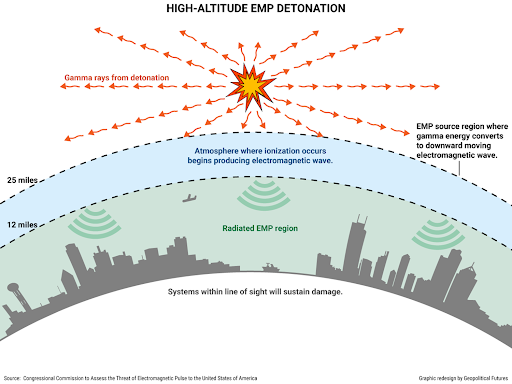An EMP (electromagnetic pulse) attack can instantly disable or destroy electronics, including everything from your smartphone and refrigerator to your home’s power supply and backup systems.
Most people assume these events are rare or only concern military targets, but the truth is, a powerful EMP, whether from a high-altitude nuclear detonation, solar flare, or specialized weapon, can strike without warning.
The aftermath can include long-term power outages, loss of communication, and a total shutdown of critical infrastructure, leaving unprepared households completely vulnerable.
So, how can you protect your home from an EMP attack?
- Start by installing a whole-house surge protector to help block excess voltage.
- Consider shielding essential electronics in a Faraday cage or purchasing EMP protection bags.
- You may also want to invest in a backup power source, ideally a generator with EMP-resistant components, to maintain basic electricity in a worst-case scenario.
Keep reading to learn how to protect your home from an EMP attack. Let’s start by defining EMP attacks and why they occur.
Contents
Key Takeaways
- EMP attacks can permanently damage unshielded electronics, even if they are unplugged
- Faraday cages, EMP-rated bags, and shielded rooms help protect devices from damage
- Backup power systems, like EMP-resistant generators and solar setups, are critical
- Emergency kits should include manual tools, water, food, and protected communication devices
- Educating your family and assigning roles ensures a coordinated response after an EMP

What Is an EMP Attack?
An EMP attack is a burst of electromagnetic energy that can disrupt or destroy electronic devices. This sudden energy pulse can cause voltage spikes and current surges, damaging or destroying sensitive electronic components in your devices and appliances.
EMPs can be generated by various sources, both natural and human-made. Depending on the intensity of the pulse and the device’s vulnerability, the effects can range from temporary malfunctions to permanent damage.
Examples of EMP Attacks
Although many people associate EMPs with human-made devices designed to cause disruptions, other common sources include nuclear explosions and solar flares, as discussed below.
- Nuclear Explosions: When a nuclear bomb detonates, it releases a massive amount of electromagnetic energy that can cause an EMP. The high-altitude detonation of a nuclear weapon can generate an EMP that spans hundreds of miles, affecting a wide area. According to Gunnery Sergeant Joshua E. Owen, both Russia and China have the ability to potentially detonate nuclear devices over US airspace, which can result in the widespread damage and destruction of electronics.
- Solar Flares: The sun periodically releases intense bursts of energy called solar flares. These flares can cause geomagnetic disturbances on Earth, potentially leading to EMPs that can disrupt electronic systems and power grids. The sun periodically releases intense bursts of energy called solar flares. These flares can cause geomagnetic disturbances on Earth, potentially leading to EMPs that can disrupt electronic systems and power grids. One such example occurred in 1989, when the sun released solar flares that caused power grids in Quebec, Canada, to fail for up to nine hours.
- Human-Made EMP Devices: Specialized devices can be engineered to generate EMPs. These devices, often called “EMP bombs” or “E-bombs,” can be used as weapons to target specific areas or facilities, causing localized electronic disruptions. With the global EMP market predicted to increase at a CAGR of 5.2% between 2024 and 2032, reaching an estimated $0.08 billion, (not accounting for military expenditures), protecting your home from man-made EMP attacks is becoming more important.
Effects of an EMP Attack on Home Electronics
An EMP attack can severely disrupt or destroy your home’s electronics, leaving you without power, communication, and basic services.
Understanding the specific effects on different systems within your home will help you take targeted steps to prepare. Below, we break down the main areas of vulnerability, including unplugged devices, the electrical grid, communication systems, and modern appliances.
Damage to Unplugged Devices
Many people believe unplugging devices is enough to protect them from an EMP, but this is not always true. A powerful EMP can induce strong electrical currents in any conductive material, including wiring and internal circuits, even when a device is not plugged into an outlet.
As a result, smartphones, laptops, televisions, and other electronics may still be permanently damaged. Sensitive microchips and circuit boards are especially vulnerable.
Protecting Unplugged Devices: Store essential devices in Faraday cages or EMP-rated storage bags to mitigate this risk. These shield electronics from electromagnetic energy and are a simple, cost-effective protection method.
Disruption of the Electrical Grid
One of the most serious consequences of an EMP attack is the potential collapse of the power grid. High-voltage transformers, substations, and transmission lines are particularly at risk.
If these systems fail, widespread power outages can last for weeks or even months, depending on the scale of the damage and the availability of replacement equipment. Without power, you lose access to lighting, climate control, refrigeration, and many other essential services.
Protecting Against Electrical Grid Disruptions: To prepare, consider installing an off-grid power solution such as a portable solar generator, ideally one with EMP-rated shielding.
Impact on Communication Systems
An EMP can severely impact communications by damaging or disabling cell towers, satellites, landlines, and internet infrastructure. In the immediate aftermath, you may be unable to contact family members, access emergency broadcasts, or use GPS services.
Protecting Against Communication Disruptions: Keep backup communication tools such as hand-crank radios or EMP-hardened two-way radios in your emergency supplies to stay connected. When not in use, store them safely in a Faraday container.
Potential Appliance Failure
Modern home appliances often include electronic components, making them highly susceptible to EMP damage. Refrigerators, washing machines, HVAC systems, and smart devices can all be affected. While older mechanical appliances may continue to function, many homes rely on digital controls that could fail entirely.
Protecting Against Appliance Failure: To reduce your risk, unplug appliances when not in use and avoid relying solely on smart-home features. Consider mechanical or non-digital alternatives as backups for critical needs like food storage or water pumping.
EMP Protection Strategies for Your Home
To reduce the impact of an EMP attack on your home, you need both shielding and contingency planning. These strategies not only help protect your electronics from immediate damage but also ensure you have the tools and resources to function without the power grid.
Below, we cover simple steps for protecting electronics, maintaining communication, and securing backup power.
Using Faraday Cages for Sensitive Electronics
One of the most effective ways to shield essential devices is with a Faraday cage. These enclosures, made from conductive materials, block electromagnetic fields by redirecting the energy around the exterior. This makes them ideal for protecting small electronics like radios, flashlights, power banks, and solar chargers.
You can create a simple and inexpensive Faraday cage at home using a metal trash can with a tight-fitting lid, lined with non-conductive insulation like cardboard or foam.
For smaller items, EMP-proof bags offer a portable and convenient solution. Backup devices should be stored in these containers before an event occurs, as shielding only works if they are inside at the time of the pulse.
While some assume that items like microwave ovens can serve the same purpose, most are not reliable for full EMP protection unless specifically tested.

Adding Shielding to Your Home
While shielding individual devices is useful, adding structural protection to parts of your home can offer broader security. Incorporating shielding materials such as copper mesh, aluminum sheeting, or conductive fabrics into your home’s structure can help create a designated safe area for critical equipment.
For example, shielding paints applied to interior walls and ceilings can reduce electromagnetic penetration. Similarly, window films with metallic coatings can block some of the radiation that might enter through glass.
These materials are most effective when used to reinforce a specific room, such as a garage or basement, which can then serve as a protected storage or living area in a grid-down situation. This type of shielding is more complex and costly, but when combined with other measures, it adds an extra layer of defense for high-value equipment or medical devices.
Installing Backup Power Solutions
Even with strong shielding, there’s still a risk of losing access to grid electricity. Therefore, it’s essential to plan for independent power sources that can sustain your household for days or even weeks.
A generator that uses minimal electronics, or one designed to withstand an EMP, can provide immediate power for basic needs. Diesel and propane models tend to be more rugged and easier to maintain. If you prefer renewable energy, solar panels with EMP-shielded inverters are a viable option, especially when paired with an off-grid battery bank for energy storage.
However, it’s important to remember that standard grid-tied solar systems will likely shut down during a blackout. For true independence, choose a standalone or hybrid setup that can function without grid support. In all cases, protect any electronic components with EMP-rated surge protection or store backups in a Faraday cage.
Securing Communication Equipment
Maintaining communication can be just as important as having power in a widespread EMP event. With traditional infrastructure likely offline, you’ll need backup devices that can operate independently.
To prepare, keep a hand-crank or battery-powered NOAA weather radio in your emergency kit. Shortwave radios and walkie-talkies can help you stay informed and coordinate with others nearby. Satellite phones are ideal for longer-range communication, but they should also be shielded when not in use.
Store communication tools in a Faraday cage or EMP-rated storage bag whenever possible. This extra step ensures that your backups will still function even if your primary devices are damaged.
Reinforcing Home Security
An EMP attack can also disable electronic security systems, including alarms, smart locks, and surveillance cameras. Without these systems, your home could be more vulnerable to break-ins, especially if the power remains out for an extended period.
Install physical barriers such as deadbolts, reinforced door frames, and window bars to maintain security. Motion-activated solar lights are another useful option, as they can function independently of the grid and help deter intruders after dark.
If you rely on electronic security, look for EMP-resistant systems or analog backups. For longer outages, securing a portion of your home or property may also be wise for storing food, fuel, and emergency supplies with added physical protection.
How to Prepare Your Home for an EMP Event
Preparing your home for an EMP event means identifying vulnerabilities, planning for disruptions, and building systems that function independently of the grid. The steps below will help protect your electronics, preserve access to critical resources, and ensure your family is ready to act.
Assessing Your Home’s Vulnerabilities
Begin by understanding what parts of your home are most susceptible to EMP-related damage. This includes both electronic devices and structural elements that could allow electromagnetic energy to penetrate.
Identifying Critical Electronics
Make a list of all devices your household depends on. Focus on items like refrigerators, medical equipment, water pumps, lighting systems, and communication tools.
Prioritize protecting devices that are either essential for safety or difficult to replace quickly.
Older mechanical devices are less vulnerable, so where possible, consider switching to analog alternatives that don’t rely on microchips or digital controls.
Examining Structural Weaknesses
Next, inspect your home for areas where electromagnetic radiation could easily enter. Pay attention to large glass windows, uninsulated walls, and exterior-facing doors. These entry points are more vulnerable unless they’re reinforced with shielding materials.
Also, review your home’s electrical setup. Check for proper grounding, surge protection, and whether your wiring is shielded. Grounded systems are better equipped to withstand brief surges, though they may not stop a high-intensity pulse.
Addressing Cybersecurity Concerns
Although an EMP affects physical systems, it’s wise to consider your digital assets. Back up critical documents, photos, and passwords on external hard drives or flash drives, then store them in a Faraday container. This protects valuable data from being lost if connected devices are damaged.
Creating an EMP Preparedness Plan
Once you’ve identified your weak points, the next step is to develop a practical plan that your entire household can follow.
Assigning Family Roles
Assign specific tasks to each household member. These roles might include collecting water, managing food supplies, securing the home, or monitoring communications. Having clear responsibilities avoids confusion during an emergency.
Setting Up an EMP-Safe Room
Designate a secure area in your home where sensitive electronics and emergency supplies can be stored. Ideally, this should be a basement, garage, or interior room that can be lined with shielding materials such as aluminum or copper mesh.
Store your Faraday cages, emergency kit, and backup equipment here. Reinforcing even a single room can provide a central fallback location during an outage.
Planning for Off-Grid Living
Think through how your household will function without electricity. Include alternatives for:
- Cooking: Propane stoves, solar ovens, and portable grills
- Lighting: Oil lamps, candles, or LED lanterns with manual charging options
- Heating: Wood-burning stoves or kerosene heaters (with proper ventilation)
Practice using these tools in advance so everyone knows how they work.
Building an EMP-Resistant Emergency Kit
Your emergency kit should be tailored to withstand EMP effects while also supporting daily survival needs for at least two weeks.
Core Survival Supplies
Focus on durable, manual tools and low-tech equipment that won’t fail under electromagnetic stress. Include:
- First aid supplies
- Thermal blankets and weather-appropriate clothing
- Tents or tarps for emergency shelter
- EMP-resistant radios and solar-powered flashlights
Non-Electronic Cooking and Lighting Tools
Avoid relying on anything that needs the grid. Include:
- Manual can openers and cooking utensils
- Cast iron pots or pans for open-flame cooking
- Matches, lighters, and fire-starting kits
- Kerosene or oil lamps with extra fuel
Water and Food Storage
Stockpile non-perishable foods such as canned goods, dried beans, rice, and freeze-dried meals. Rotate your supply regularly.
Store water in BPA-free containers and consider adding:
- A gravity-fed filtration system
- Collapsible water containers
- Rainwater collection barrels (if legal in your area)
Educating Your Family on EMP Readiness
Even the best plan will fall short if your family isn’t prepared to carry it out. Education and hands-on practice are essential.
Teaching Practical Skills
Help each family member learn at least one skill that will be useful in a power outage. Examples include:
- Administering first aid
- Starting a fire safely
- Filtering and purifying water
- Operating shortwave or ham radios
Practice these skills during regular preparedness drills so they become second nature.
Reviewing and Updating the Plan
Schedule periodic family meetings to review your plan, check supply expiration dates, and test your backup systems. Update responsibilities as needed to reflect age or ability changes.
Reinforcing Mental Preparedness
Lastly, focus on building a mindset of cooperation and calm. Let your family know that staying level-headed during a crisis can make a meaningful difference. Reassure them that having a plan, tools, and clear roles puts you in a stronger position than most households.
What Are the Best EMP-Proof Generators for Home Use?
When selecting an EMP-proof generator for your home, consider models specifically designed to withstand electromagnetic pulses. These generators typically feature EMP-resistant components, such as shielded wiring, protected control panels, and hardened electronics.
Some of the top EMP-resistant generator models include:
- Winco EMP-Proof Generators: These generators are built with military-grade shielding and filtering to protect against EMP damage. They offer a range of sizes and power outputs to suit various home needs.
- EMP Shield Solar Generators: These portable solar generators are equipped with EMP-shielded inverters and charge controllers. They provide clean, renewable energy and can be easily stored in a Faraday cage when not in use.
- Yanmar EMP-Protected Diesel Generators: Yanmar’s line of EMP-protected diesel generators features robust shielding and heavy-duty construction. They are designed for reliable operation in the event of an EMP attack.
When choosing an EMP-proof generator, look for key features such as:
- Military-grade EMP shielding and filtering
- Automatic voltage regulation to protect against power surges
- Rugged, durable construction to withstand harsh conditions
- Compatibility with your home’s power requirements and backup energy needs
Ensuring Your Generator Is Prepared for an EMP
Proper storage and maintenance of your EMP-proof generator are essential to ensure its readiness and longevity. How to maintain and test your EMP-proof generator involves regular inspections, fuel stabilization, and periodic test runs.
- Keep your generator in a secure, EMP-shielded location when not in use, such as a Faraday cage or a specially designed EMP-resistant enclosure.
- Remember to store an adequate supply of fuel for your generator, rotating and replacing it as needed to maintain freshness.
- Regularly check and replace filters, oil, and other consumables according to the manufacturer’s recommendations.
By investing in a high-quality, EMP-proof generator and following proper storage and maintenance practices, you can ensure a reliable backup power source for your home in the event of an EMP attack. How to integrate an EMP-proof generator into your home’s electrical system requires professional installation and adherence to local building codes and regulations.
Is EMP-Proofing Your Home Worth the Investment?
Yes, EMP-proofing your home is worth the investment, especially if you want to protect your critical electronics, communication tools, and power systems during a worst-case scenario. An EMP event can strike without warning and result in prolonged power outages, total loss of connectivity, and widespread failure of modern appliances.
However, with the right precautions, such as shielding electronics, setting up off-grid power, and educating your family, you can maintain a level of security and independence that most households lack. These steps do require planning and resources, but they offer lasting peace of mind in an increasingly unpredictable world.
Safeguard your home and electronics against EMP threats with Batten Cyber’s expert security recommendations. Learn how to protect your critical devices and power sources with the right tools and strategies. Visit Batten Cyber today to explore EMP protection solutions!
Frequently Asked Questions
Can an EMP Penetrate Underground Shelters?
Yes, but the risk is lower. Deep shelters with concrete and metal layers offer some natural shielding but should still include Faraday protection for electronics.
How Long Would It Take to Recover From a Large-Scale EMP?
Recovery could take weeks to months depending on the severity, affected region, and availability of replacement grid infrastructure and electronics.
Do Cars Still Work After an EMP Attack?
Most modern cars may be disabled due to sensitive electronic components. Older vehicles without electronic ignition systems are more likely to keep running.
Is There a Difference Between Military and Civilian EMP Protection?
Yes. Military-grade protection uses hardened enclosures and redundant systems, while civilian options are often DIY or partial solutions designed for home use.
Can Solar Panels Survive an EMP?
The panels themselves can survive, but the inverter and charge controller are vulnerable. Store spare components in a Faraday cage for added protection.





